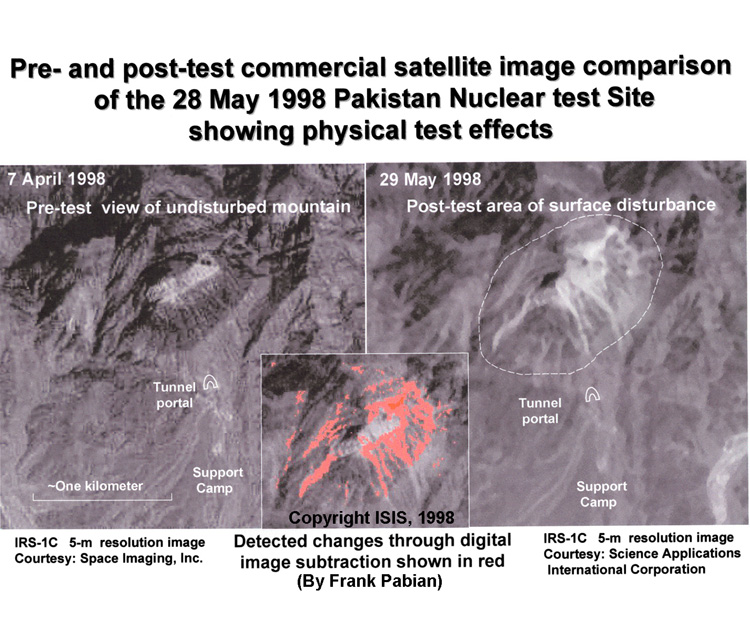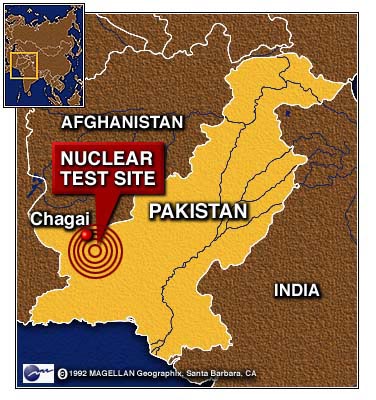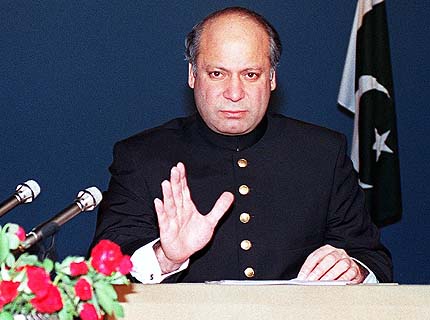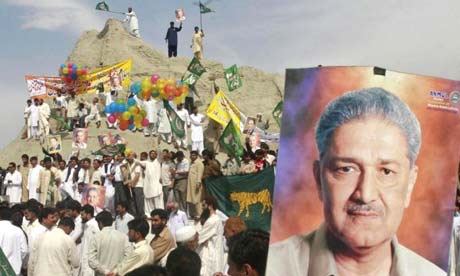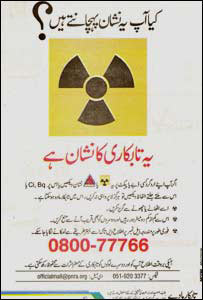رد: 28 مايو يوم تاريخى اول تفجير قنبله اسلاميه. يوم تكبير في باكستان
اطول 30 ثوان في حياتى عندما انا اضغط زر و انتظر لتفجير 5 قنابل نووي
عندما تسير الجبال -- قصة تشاجاى
كاتب راي محمد صالح عزام يعطي وصفا تفصيليا للأحداث والشخصيات التي تؤدي إلى انفجار باكستان النووية الاولى. (بإذن من الأمة)
عبرت العتبة النووية باكستان أن تصبح دولة تمتلك أسلحة نووية وأعلن في 28 مايو 1998 ، بعد أن فجر خمسة أجهزة نووية في تلال راس كوه في تشاغاي ، بلوشستان.
العلاقة مع تشاجاى الأسلحة النووية الباكستانية أول برنامج أصبح معروفا للجمهور الباكستاني والعالم مرة أخرى في 1990s في وقت مبكر عندما نشر كتاب ، الكتلة الحرجة ، التي كتبها وليام بوروز وروبرت Windrem.
ومع ذلك ، فإن القصة أبعد من ذلك.
تشاجاى : الخلفية
وبدأت قصة تشاجاى في كويتا بلوشستان في عام 1976 عندما العميد. تلقى محمد سارفراز ، رئيس الأركان في مقر فيلق 5 انتقال من المقر العام للجيش باكستان (القيادة العامة) وروالبندي. ووجه رسالة إلى قائد فيلق لتوفير طائرة هليكوبتر عسكرية الى فريق من العلماء القادمة من لجنة الطاقة الذرية الباكستانية (مجلس الطاقة النووية) لاستطلاع التنفيذية لبعض المناطق في بلوشستان.
وسقط فريق يضم مجلس الطاقة النووية الدكتور إشفاق أحمد ، عضو (فني) ، والدكتور احسان مبارك في كويتا وقدمت الطائرة وفقا لتعليمات القيادة العامة. على مدى فترة ثلاثة أيام ، والعلماء مجلس الطاقة النووية التي جولات استطلاع عدة من المنطقة الواقعة بين توربات ، وAwaran Khusdar في الجنوب وNaukundi Kharan في الشرق.
ويتمثل هدفها في إيجاد موقع مناسب لتجربة نووية تحت الأرض ، ويفضل أن جبلا.
بعد تفتيش دقيق المحمومة وجدوا الجبل الذي يقابل مواصفاتها. وكان هذا الجبل 185 مترا الغرانيت عالية في تلال راس كوه في شعبة تشاجاى بلوشستان التي في صعوده إلى أعلى نقطة على ارتفاع 3009 متر. رأس كوه تلال تكون مستقلة وينبغي عدم الخلط بين تلال تشاغاي في الشمال على الحدود بين أفغانستان وباكستان ، والتي ، حتى الآن ، أي نشاط للتجارب النووية قد حدثت.
وكان مجلس الطاقة النووية شرط أن الجبل يجب أن يكون "العظام الجافة" وقادرة على تحمل انفجار 20 kilotonne النووي من الداخل. وأجريت اختبارات لقياس محتوى المياه من الجبال والمناطق المحيطة بها ، وقياس القدرة على صخرة الجبل على تحمل تجربة نووية. مرة واحدة وأكد هذا ، والدكتور أحمد إشفاق بدأ العمل على اجراء مسح ثلاثى الابعاد لهذه المنطقة.
وكان هذا المسح استغرق سنة واحدة لإجراء و، في عام 1977 ، فقد تقرر أن يكون بالملل النفق المقترح في الجبل يجب أن يكون إثقال كاهل جبل مرتفع فوق 700 متر ، مما يجعل ما يكفي لتحمل 20 كيلو طن من القوة النووية. في نفس العام ، العميد. استدعي محمد سارفراز ، الذين ، في هذه الأثناء ، كان قد نشرها إلى القيادة العامة لشرطة روالبندي ، من قبل الرئيس ضياء الحق المجاهدين ، وقيل ان مجلس الطاقة النووية أراد أن عقد الإيجار له من الجيش للقيام بأعمال مماثلة لبرنامج باكستان النووي. وأدى ذلك إلى إنشاء لجنة الاشغال التنمية الخاصة (SDW) ، وهي شركة تابعة للجنة الطاقة الذرية الباكستانية لكن التقارير مباشرة إلى رئيس أركان الجيش الذي أوكلت إليه مهمة إعداد مواقع التجارب النووية. العميد. سارفراز ، لجميع الأغراض العملية ، يرأس SDW ، وهو البديل النووي للجيش الباكستاني الشهير منظمة يعمل الحدودي (FWO) التي بنيت طريق كاراكوروم السريع.
وتتمثل المهمة الرئيسية للمنظمة وإعداد مواقع التجارب تحت الأرض (الأفقي والرأسي مهاوي) لأجهزة نووية 20 kilotonne ، مع كل الحلفاء البنية التحتية والمرافق. وقال إن المواقع التي تكون مصممة بطريقة يمكن استخدامها أنها في وقت قصير (في أقل من أسبوع) ، وكان من المقرر أن تكتمل بحلول ديسمبر 1979 على أبعد تقدير.
بعد سلسلة من الاجتماعات بين المسؤولين وSDW جنة الطاقة الذرية الباكستانية ورئيس باكستان ، تقرر أن SDW أن تعد 2-3 مواقع منفصلة. لذا ، كان يوجد موقع ثان للرمح في Kharan الأفقي ، في واد بين تلال الصحراء كوه رأس إلى الشمال والمدى Siahan الى الجنوب.
وفي وقت لاحق ، أصبحت تشاجاى راس كوه - Kharan دخول المناطق المحظورة والمناطق كانت مغلقة أمام الجمهور ، مما دفع باكستان الشائعات التي أعطت قواعد جوية للولايات المتحدة. وحقيقة أن الولايات المتحدة ومساعدات أقامت مكتبا في توربات ، وأضاف بلوشستان فقط وقود لهذه الشائعات.
وقدم 3325 نفق طويل كان يشعر بالملل في تلال كوه الذي كان رأس 8-9 أقدام في قطر ، وكان على شكل الخطاف ليكون الختم الذاتي. وكان موقع التجارب في Kharan 300 من 200 قدم ، وكان لام الشكل. وكان كل من مواقع اختبار مجموعة واسعة من الكابلات وأجهزة الاستشعار ومحطات الرصد. وبالإضافة إلى الأنفاق الرئيسية ، التي بنيت SDW 24 مواقع التجارب الباردة ، 46 و 35 من الأنفاق قصيرة الإقامة تحت الارض للقوات والقيادة والسيطرة ومرافق الرصد. كوه في رأس ، وتقع بعض هذه الجرانيت داخل الجبال.
كل من مواقع التجارب النووية في كوه رأس وKharan 2-3 سنوات لإعداد واستكملت في عام 1980 ، قبل أن باكستان حصلت على القدرة على تطوير سلاح نووي. وأظهرت هذه الثقة بالنفس والعزم على حد سواء في البرنامج النووي الباكستاني ، وكذلك الإيمان بالله سبحانه وتعالى.
الفريق واه : المصممين ومصنعي الأجهزة النووية الباكستانية
في آذار / مارس 1974 ، حفيظ قريشي ، الذي كان في ذلك الوقت كانت متجهة من الإشعاع وتطبيقات النظائر شعبة (رياض) في معهد باكستان للعلوم والتكنولوجيا (PINSTECH) على قدم المساواة وNilore مهندس ميكانيكي التميز ، استدعي من قبل ثم رئيس مجلس الطاقة النووية ، منير احمد خان في الاجتماع الذي حضره ، من بين أمور أخرى ، من قبل الدكتور عبد السلام ، ثم مستشارا للعلوم والتكنولوجيا لحكومة باكستان ، والدكتور رياض سعود ، الدين ، عضو (فني) ، مجلس الطاقة النووية. وقال قريشي انه تعاون في مشروع من أهمية وطنية مع خبير آخر ، والدكتور الشيخ زمان ، ثم عمل مع DESTO. لم يكن أبدا استخدام كلمة "قنبلة" في الاجتماع ولكن قريشي يعرف بالضبط ما كان يجري طلب منه القيام به. لن تكون مهمتهم لبناء آليات للقنبلة. سوف يقع المشروع في واه ، القادم مناسب لمصانع المعدات الحربية (باكستان) (ميناء الفجيرة) ، في مقاطعة الحدود الشمالية الغربية وإغلاق مريح الى العاصمة اسلام اباد.
وبدأ العمل في واه بموجب قانون للبحوث وقريشي ، زمان وفريق من المهندسين والعلماء أصبح يعرف باسم "مجموعة واه". واقتصر عمل أولية للبحث والتطوير من المتفجرات لاستخدامها في سلاح نووي. ومع ذلك ، فإن اختصاصات توسيع نطاقها لتشمل المواد الكيميائية والميكانيكية والهندسية الدقيقة وآليات تحريك. شراء معدات وحيث قد وضعت التكنولوجيا الخاصة بها حيث منعت القيود المفروضة على شراء المعدات.
التلال Kirana : إن الاختبارات الباردة
وأجري اختبار باكستان الباردة الأولى من برنامجها النووي خارج الجهاز في 11 مارس 1983 في تلال قرب Kirana سرغودا ، منزل القاعدة الجوية للقوات الجوية الباكستانية الرئيسية والمركزية مستودع الذخيرة (كندي). اختبار الباردة (ط م) هو وسيلة لاختبار عمل جهاز نووي من دون انفجار. ويتحقق ذلك عن طريق إحداث قنبلة الفعلية دون المواد الانشطارية اللازمة لتفجيرها. وكان يشرف على اختبار الدكتور إشفاق أحمد.
أنفاق في تلال Kirana ، وتفيد التقارير سرغودا قد بالملل بعد التجربة النووية المواقع تشاجاى ، أي في وقت ما بين عامي 1979 و 1983. كما هو الحال في تشاغاي ، كان يشعر بالملل الأنفاق في تلال Kirana ثم تختم وأجريت أيضا هذه المهمة SDW.
قبل التجارب الباردة ، وفريق متقدم أرسلت إلى ختم دي ، وفتح وتنظيف الأنفاق وللتأكد من أن الأنفاق كانت واضحة من الخنازير البرية التي توجد بكثرة في منطقة سرغودا. ولم يتسن على الضرر الذي هذه الخنازير البرية يمكن القيام به ليكون الرجال والمعدات بأقل عندما يكون أحد الخنازير البرية مثل هذه التكاليف في وقت لاحق في القوات الجوية الباكستانية من طراز اف 16 عندما المنفصمة قبالة عجلات الطائرة الأمامية كما جاءت في الهبوط في قاعدة سارجودها الجوية. لحسن الحظ ، ان الطيار قفز من يعانون من إصابات طفيفة. والمراد كتابتها 20 مليون دولار من طراز اف 16 ، مع ذلك ، دمرت ، وكان الخروج.
بعد إزالة الأنفاق ، وفريق مجلس الطاقة النووية التشخيص برئاسة الدكتور Mubarakmand صلت الى مكان الحادث مع مقطورة مزودة بأجهزة كومبيوتر ومعدات التشخيص. وأعقب ذلك وصول الفريق واه مع الجهاز النووي ، في شكل شبه التجمع. تم تجميع هذا ثم وضعت داخل النفق. وأنشئ نظام الرصد مع نحو 20 الكابلات التي تربط أجزاء مختلفة من الجهاز مع مؤشرات التذبذب في شاحنات كانت متوقفة بالقرب من التشخيص هيلز Kirana. وقال إن الفريق واه المتقدمة محليا وموضوعة في المتفجرات (المتفجرات جلالة الملك) الذي كان يستخدم لتشغيل الجهاز.
وكان جهاز اختبار باستخدام تقنية الضغط على زر خلافا لتقنية الراديو وصلة تستخدم في تشاغاي أربعة عشر عاما في وقت لاحق. وكان أول اختبار لمعرفة ما إذا كان إنشاء آلية تحريك الدعوى النيوترونات الضرورية التي من شأنها أن تبدأ سلسلة من ردود الفعل في الانشطار قنبلة حقيقية. ومع ذلك ، وعندما تم الضغط على زر ، أكثر من أسلاك توصيل الجهاز على مؤشرات التذبذب قطعت بسبب الأخطاء التي ارتكبت في التحضير للكابلات. في البداية ، كان يعتقد أنه حدث خلل في الجهاز ولكن مزيد من التدقيق لاثنين من المؤشرات أكدت أن النيوترونات قد حان فعلا بها وسلسلة من ردود الفعل قد وقع. وكان اختبار باكستان الباردة الأولى من قنبلة نووية كانت ناجحة و11 مارس 1983 أصبح يوم لا ينسى في تاريخ لبرنامج باكستان النووي. وأجري اختبار الباردة الثانية بعد ذلك بوقت قصير الذي شهدته غلام اسحق خان ، اللفتنانت جنرال كم عارف خان وأحمد منير.
الحاجة إلى تحسين والكمال في تصميم جهاز النووية الباكستانية الأولى المطلوبة اختبار مستمر. ونتيجة لذلك ، بين عامي 1983 و 1990 ، أجرى الفريق أكثر من 24 واه الباردة اختبارات لجهاز نووي في تلال Kirana بمساعدة معدات التشخيص النقالة. وأجريت هذه الفحوص في كل من الأنفاق قياس 24 قدما في الطول 100-150 التي كانت بالملل داخل تلال Kirana. كان من المقرر في وقت لاحق لاجهزة الاستخبارات الاميركية المفرطة والتركيز الصناعي على موقع تلال Kirana ، التخلي عنها وتحول المنشأة ط م إلى المدى كالا Chitta.
بحلول آذار / مارس 1984 ، وكان البحث مختبرات كاهوتا (KRL) نفذت بشكل مستقل من تجاربها الخاصة الباردة نووي بالقرب كاهوتا.
وخلال نفس الفترة 1983-1990 ، وذهب فريق واه على لتصميم وتطوير قنبلة صغيرة بما يكفي لتكون محمولا على جناح مقاتلة صغيرة مثل إف 16. وهي تعمل جنبا إلى جنب مع القوة الجوية الباكستانية) لتطوير تقنيات وتسليم كامل لقنبلة نووية باستخدام الطائرات المقاتلة بما في ذلك 'السقوط الحر التقليدية ، قصف مخزن الغلال' '،' إرم تفجير و 'تقنيات الهجوم laydown على مستوى منخفض. اليوم ، وقد اتقن جميع التقنيات القوات الجوية الباكستانية أربعة من تسليم الأسلحة النووية باستخدام وإف 16 وميراج الخامس وطائرة قتالية - 5.
التحدي الهندي
في 11 و 13 مايو 1998 ، أجرى الهندي ما ادعى ما مجموعه 5 التجارب النووية في بوخران ، وراجستان قرب الحدود مع باكستان وأعلنت نفسها "دولة تمتلك أسلحة نووية". زعزعة استقرار هذا العمل من جانب الهند على توازن القوى في جنوب آسيا بشدة لصالح الهند. وكان الغبار في بوخران حتى الآن لتسوية عندما مسؤولين كبار في الحكومة والعسكريين الهندي بدأ اصدار البيانات الاستفزازية ضد باكستان. أعلنت الهند أنها تنتهج "الاستباقية" سياسة بشأن جامو وكشمير. وأبلغت باكستان من أجل تحقيق "الجديد الواقع الجغرافي السياسي في جنوب آسيا".
وكانت الرسالة الأساسية لهذه باكستان "تتخلى عن مطالبة الخاصة بك على جامو وكشمير ، وتصبح خاضعة للهيمنة إلى الأبد الهندي في جنوب آسيا". الهند هي الآن أسلحة نووية السلطة وباكستان لم يكن. ولذا ، فمن يسمح باكستان التي يجب الاستسلام على جامو وكشمير ، وفقط تملي الهند في جنوب آسيا. في حالة وقوع حرب اخرى بين الهند وباكستان ، والهند تكون قادرة على استخدام الأسلحة النووية إذا قواتها المسلحة انهزموا أو وضع في زاوية ضيقة. ورأى الهندي warplanners أن استخدام أجهزة نووية صغيرة المعركة ضد معسكرات الجيش وباكستان ، والمدرعة والمشاة والأعمدة وقواعد القوات الجوية الباكستانية النووية والمنشآت الصناعية العسكرية لن يجتمع مع رد فعل سلبي من المجتمع الدولي ما دام يمكن أن يبقى إلى سقوط ضحايا من المدنيين كحد أدنى. بهذه الطريقة ، سيكون هزيمة الهند وباكستان ، وقوة قواتها المسلحة إلى الاستسلام المهين واحتلال والمرفق في المناطق الشمالية من باكستان وازاد جامو وكشمير. الهند وباكستان نحت بعد ذلك الى دول صغيرة على أساس الانقسامات العرقية والتي من شأنها أن يكون نهاية للمشكلة باكستان "" مرة واحدة وإلى الأبد.
لا يمكن أبدا أن مثل هذه الخطة يمكن السماح للنجاح. في مواجهة البقاء على قيد الحياة الوطنية ، وكلها أمور أصبحت ثانوية. ولذلك ، تقرر ان باكستان تتجه نحو التسلح النووي لضمان أمنها وبقائها.
الطريق إلى تشاغاي
وعقد اجتماع للجنة الدفاع في مجلس الوزراء (دي سي سي) صباح يوم 15 مايو 1998 في الأمانة العامة لرئيس الوزراء ، واسلام اباد لبحث الوضع الناجم عن التجارب النووية في الهند. وكان الاجتماع برئاسة رئيس وزراء باكستان ، وحضره وزير الدفاع ، وزير الشؤون الخارجية ، وجوهر أيوب خان ، وزير المالية والشؤون الاقتصادية ، سارتاج عزيز ، وزير الخارجية ، شمشاد احمد خان والرؤساء الثلاثة لأركان الجيش والقوات الجوية والبحرية ، وهما جهانجير كرامات العام ، قائد القوات الجوية المارشال برويز مهدي قريشي والأدميرال بخاري الفصيح على التوالي.
وانخفض منذ الدكتور إشفاق أحمد ، رئيس مجلس الطاقة النووية كان في زيارة الى الولايات المتحدة وكندا مسؤولية إعطاء تقييم تقني التجارب النووية الهندي والباكستاني التأهب للرد مطابقة للهند على عاتق الدكتور سمر Mubarakmand ، عضو (فني) ، مجلس الطاقة النووية. وكان الدكتور Mubarakmand المسؤول عن مديرية مجلس الطاقة النووية في التنمية التقنية (اليومي) ، واحدة من أكثر المنظمات السرية في برنامج باكستان النووي في الموقع الذي هو واحد من أسرار باكستان أفضل الاحتفاظ بها وغير معروفة للعالم. وكان الدكتور أشرف Mubarakmand الباردة اختبارات عدة منذ عام 1983 وكان مسؤولا عن الإشراف على جميع المشاريع في مجلس الطاقة النووية السرية. أيضا ، وكان بين الحضور الدكتور A.Q. خان ، مدير مختبرات خان للابحاث (KRL) ، كاهوتا.
هناك نقطتين في جدول أعمال مجلس دبي الثقافي في : أولا ، أم لا ينبغي أن باكستان إجراء تجارب نووية وذلك للرد على التجارب النووية الهندي؟ وثانيا ، اذا كانت باكستان لا المضي قدما في الاختبارات ثم أي من المنظمتين ، أو KRL جنة الطاقة الذرية الباكستانية ، ينبغي إجراء الاختبارات؟
وتابع المناقشات حول لبضع ساعات وشملت والدبلوماسية المالية والعسكرية والاستراتيجية والشواغل الأمنية الوطنية. وكان وزير المالية سارتاج عزيز الشخص الوحيد الذي عارض اختبارات لأسباب مالية بسبب الركود الاقتصادي ، وانخفاض احتياطى النقد الاجنبى للبلاد وتأثير العقوبات الاقتصادية التي لا مفر منها ستفرض على باكستان لو انها نفذت عملية الاختبارات. رئيس الوزراء نواز شريف لا تعارض ولا المقترحة الاختبارات. وتحدث المتبقية لصالح إجراء الاختبارات.
في حين يعطي تقييمه التقنية نيابة عن مجلس الطاقة النووية ، وقال الدكتور Mubarakmand ان باكستان لديها للدولة من أحدث المعايير الدولية الحديثة محطة رصد الزلازل بالقرب من العاصمة إسلام أباد ، وأيضا محطات رصد الزلازل في كل أنحاء باكستان بما في ذلك في مواقع قرب على الحدود بين باكستان والهند. وقال ان محطات رصد الزلازل سجلت هذه واحدة فقط نووية في 11 مايو 1998 في بوخران وليس ثلاثة كما تدعي الهند وظلما. وكانت أي وقال ان اثنين المتبقية ، في جميع الاحتمالات ، وسرعان ما انهارت ، والفشل. وقال أيضا إنه لم يجر أي اختبار نووي حراري أو الهيدروجين خارجا على إما 11 أو 13 مايو 1998 من قبل الهنود واحدا من الغلة كانت كبيرة بما يكفي لمثل هذا الاختبار. في جميع الاحتمالات ، قد حاول الهنود اختبار نووي حراري ، لكنها فشلت أيضا كان. وأضاف الدكتور Mubarakmand انه اذا تقرر ان باكستان يجب المضي قدما في تجاربها النووية الخاصة بها ، ثم على استعداد تام لجنة الطاقة الذرية الباكستانية لإجراء التجارب النووية في غضون 10 يوما.
الدكتور A.Q. خان الذي كان يتحدث نيابة عن KRL ، وأكد أيضا أن KRL مستعدة بشكل كامل وقادرة على تنفيذ تجارب نووية في غضون 10 أيام إذا أعطيت أوامر من قبل دي سي سي. وذكر الدكتور خان دي سي سي أنه KRL التي اليورانيوم المخصب الأولى ، تحويلها إلى المعادن ، وتشكيله عليه في مجالات نصف النهائي من المعادن وتصميم القنبلة الذرية على الخاصة ، وأجرى فحوصا الباردة بمفردها. وقد تحقق كل ذلك من دون أي مساعدة من مجلس الطاقة النووية. وقال ان KRL كانت مستقلة تماما في المجال النووي. ومضى الدكتور خان إلى القول أنه منذ KRL الذي كان اول اختراق المجال النووي لباكستان ، فإنه ينبغي إيلاء شرف إجراء تجارب النووية الباكستانية ، وسيكون أول يشعرون يخذل اذا لم يكن يمنح امتياز للقيام بذلك.
وهكذا نجد أن كلا من مجلس الطاقة النووية وKRL على قدم المساواة لهذه المهمة. ومع ذلك ، كان مجلس الطاقة النووية ميزتان KRL الإضافية التي لم تفعل ذلك. أولا ، كان مجلس الطاقة النووية التي قامت ببناء موقع التجارب النووية في باكستان في تشاغاي ، بلوخستان. ثانيا ، كان مجلس الطاقة النووية أكبر تجربة في إجراء الاختبارات الباردة من KRL.
وانتهى الاجتماع من دون دي سي سي أي قرار من النقاط من جدول الأعمال.
رئيس لجنة الطاقة الذرية الباكستانية ، والدكتور إشفاق أحمد ، اختصر زيارته الخارجية وعاد الى باكستان يوم 16 مايو 1998. في صباح يوم 17 مايو 1998 ، انه تلقى اتصالا من القيادة العامة لشرطة الجيش الباكستاني وروالبندي يبلغه أن تبقى على أهبة الاستعداد لقاء مع رئيس الوزراء. طلب اسلام اباد حيث ذهب يرافقه Mubarakmand الدكتور رئيس مجلس الوزراء وبعد ذلك تم استدعاء من قبل مجلس النواب رئيس الوزراء ، ورئيس مجلس الطاقة النووية عن رأيه في نقطتين التي نوقشت في الاجتماع دي سي سي 15 أيار / مايو 1998. وقال الدكتور أحمد رئيس مجلس الوزراء أن قرار لاختبار أم لا لاختبار هو أن حكومة باكستان. وفيما يتعلق التأهب مجلس الطاقة النووية والقدرة انهم مستعدون لاجبهم ، وعندما طلب منها ذلك. وقال رئيس الوزراء أن تركزت أنظار العالم على باكستان ، وعدم اجراء الاختبارات من شأنه أن يضع مصداقية برنامج باكستان النووي في شك. وكان رد رئيس مجلس الطاقة النووية ، "السيد رئيس مجلس الوزراء واتخاذ قرار ، وشاء الله ، انا اعطيكم ضمان نجاح لل". وقيل له للتحضير لاختبارات لكنها تبقى على أهبة الاستعداد لاتخاذ قرار نهائي.
ونحن نعلم أن النظام لاجراء الاختبارات وقدمت على 18 مايو 1998. منذ الاجتماع دي سي سي من 15 مايو 1998 لم تؤت ثمارا ، ويعتقد أنه تم عقد اجتماع دي سي سي أكثر الحصري في 16 أو 17 مايو 1998 حضر فقط من قبل رئيس الوزراء ، وزير الخارجية ، ووزير المالية ورؤساء ثلاثة أركان الجيش والقوات الجوية والبحرية. هذا الاجتماع لم يتم الاعتراف رسميا ولكن يجب أن يكون قد عقد اذ لم يستطع رئيس الوزراء وحده ولا لرئيس هيئة الأركان في الجيش وحده يمكن ان يكون اتخذ هذا القرار لإجراء التجارب النووية. وكان دي سي سي السلطة الوحيدة المختصة لاتخاذ قرار بشأن هذا الموضوع ، وخصوصا منذ قيام السلطة الوطنية قيادة (التحالف الوطني) ، والقيادة النووية الباكستانية ومراقبة السلطة لقواتها الاستراتيجية ، لم تكن موجودة في ذلك الوقت. في هذه الجلسة ، ونقاط جدول أعمال الاجتماع الثاني من دي سي سي من 15 مايو 1998 وقررت. أولا ، سوف تعطي باكستان مطابقة واستجابة يليق إلى الهند عن طريق إجراء تجارب نووية خاصة بها. وثانيا ، أن تسند هذه المهمة الى لجنة باكستان للطاقة الذرية (مجلس الطاقة النووية) ، الذين كانوا أفضل تجهيزا والاكثر خبرة لإجراء الاختبارات.
في 18 استدعي مرة أخرى أيار / مايو 1998 رئيس لجنة الطاقة الذرية الباكستانية للبيت رئيس الوزراء حيث كان ترحيل قرار دي سي سي. "Dhamaka الدين كار" كان (الانفجار السلوك ") عبارة التي استخدمها رئيس الوزراء ليبلغه القرار الذي اتخذته الحكومة لإجراء التجارب النووية. وذهب رئيس مجلس الطاقة النووية يعود الى مكتبه وأعطى أوامره لموظفيه للإعداد للاختبارات. في نفس الوقت ، القيادة العامة وقيادة القوات الجوية أصدرت أوامر إلى الجهات المعنية في 12 مشاة ، كويتا ، والإمداد الوطنية خلية (مؤتمر العمل النيجيري) ، وطيران الجيش ومشاة رقم 6 (دعم النقل الجوي) السرب على التوالي لتقديم الدعم اللازم للجنة الطاقة الذرية الباكستانية في هذا الصدد. هيئة الطيران المدني (الجهاز المركزي للمحاسبات) كما وجهت شركة الطيران الوطنية ، الخطوط الجوية الباكستانية ، لتوفير طائرة ركاب من طراز بوينج 737 في وقت قصير لجنة الطاقة الذرية الباكستانية تنقل من المسؤولين والعلماء والمهندسين والفنيين لبلوشستان.
وعندما وصلت أخبار الدكتور A.Q. خان في KRL التي أسندت المهمة لجنة الطاقة الذرية الباكستانية ، وقال انه قدم احتجاجا قويا مع رئيس اركان الجيش الجنرال جهانجير كرامات. قائد الجيش ، بدوره ، دعا رئيس الوزراء. وتقرر أن يشارك أفراد KRL في إعداد النهائي لموقع التجارب النووية جنبا إلى جنب مع تلك التي جنة الطاقة الذرية الباكستانية ، وكذلك الحالي في وقت الاختبار.
في غضون ذلك ، عقد اجتماع لجنة الطاقة الذرية الباكستانية تقرر طريقة عمل الاختبارات وعدد الاختبارات للقيام بها. وكان هذا الاجتماع برئاسة الدكتور أحمد ، وحضره الدكتور Mubarakmand وغيره من العلماء والمهندسين لجنة الطاقة الذرية الباكستانية. وقد تقرر أنه منذ نظرا للتجارب النووية الهندي فرصة لباكستان لاجراء التجارب النووية بعد 14 عاما من إجراء التجارب الباردة فقط ، ينبغي أن يستمد الفائدة القصوى من هذه الفرصة. ولذا ، قررت أن يتم اجراء اختبارات متعددة للخروج من غلة متفاوتة ، فضلا عن تجارب حية للآليات تحريك. منذ نفق في تلال كوه رأس لديها القدرة على إجراء ستة اختبارات ، لذلك ، وستة أجهزة نووية مختلفة من تصاميم مختلفة ، تم اختيار الأحجام والمحاصيل ، وجميعها قد تم اختباره من قبل الباردة.
وبعد ذلك مباشرة ، بدأت عملية التحقق من جودة واللياقة البدنية من مختلف مكونات أجهزة نووية ومعدات الاختبار. وتنفيذ عمليات لوجستية كبيرة ولكن على نحو سلس كما حصل حاليا مع مساعدة من الجيش الباكستاني والقوات الجوية. شملت هذه العملية نقل الرجال والمعدات ، فضلا عن أجهزة نووية لاختبار موقع رأس كوه من اجزاء مختلفة من البلاد.
في 19 أيار / مايو 1998 فريقين من العلماء جنة الطاقة الذرية الباكستانية 140 والمهندسين والفنيين لتشاجاى اليسار ، بلوشستان على اثنين من طراز بوينج 737 رحلات الخطوط الجوية الباكستانية منفصلة. كما كانوا على متنها فرق من مجموعة واه ، ومجموعة النظرية ، ومديرية التنمية التقنية (اليومي) ومجموعة تشخيص. تم نقل بعض من الرجال والمعدات عبر الطريق باستخدام شاحنات عمال نيجيريا برفقة أعضاء مجموعة الخدمات الخاصة (التدابير الوقائية الخاصة) ، وقوة كوماندوس النخبة في الجيش الباكستاني.
هم أنفسهم جوية والأجهزة النووية في طرق تماما أسفل (كد) شبه التجمع على شكل الجوية الباكستانية طائرة هرقل سي 130 قوة النقل التكتيكي من روالبندي إلى تشاغاي ، رافقه حتى داخل المجال الجوي الباكستاني من قبل القوات الجوية الباكستانية أربع إف 16s المسلحة مع جو جو. وكانت الأجهزة الأمنية كانت صارمة بحيث القوات الجوية الباكستانية من نوع (إف 16 مرافقة الطيارين كان يقف سرا اعطيت الاوامر أنه في حالة غير المرجح للطراز سي 130 التي خطفت أو جوية خارج المجال الجوي الباكستاني ، لاسقاط الطائرات قبل أن غادرت الأجواء الباكستانية. وأمر إف 16s لمرافقة سي 130 في مطار معين في بلوشستان مع كل معدات الاتصالات اللاسلكية إيقاف بحيث لا أوامر ، في هذه الأثناء ، يمكن نقل لهم للعمل على خلاف ذلك. وأمر أيضا إلى تجاهل أية أوامر على العكس من التي حصلت من خلال لهم خلال مدة الرحلة حتى إذا نشأت مثل هذه الأوامر من قيادة القوات الجوية.
مرة واحدة في تشاغاي ، اتخذت بشكل منفصل أجزاء من الأجهزة النووية لغرف صفر خمسة 'في أنفاق طويلة كيلومتر في رأس كوه في تلال تشاغاي. الدكتورة سمر Mubarakmand أشرف شخصيا على التجميع الكامل لجميع الأجهزة النووية الخمس. كانت قد وضعت بعد ذلك التشخيص الكابلات من النفق إلى القياس. كابلات توصيل جميع الأجهزة النووية الخمس مع أمر مركز مراقبة على بعد 10 كم. بعد ذلك ، جرى اختبار كامل محاكاة من قبل القيادة عن بعد. وحدث هذا عملية إعداد الأجهزة النووية ، ووضع من الكابلات ، وإنشاء قيادة وظيفية بالكامل ومركز المراقبة 5 أيام.
على الجنود مايو 1998 ، 25 من فيلق جيش باكستان 5 وصل لاغلاق النفق. كانت عظمى فيسيد من قبل المهندسين والفنيين من فيلق الهندسة في الجيش الباكستاني ، ويعمل الحدودي منظمة FWO) ، وأعمال التطوير الخاصة (SDW). مشى الدكتور سمر Mubarakmand نفسه ما مجموعه 5 كيلومترات ذهابا وإيابا في فحص الأنفاق الساخنة وإعادة التحقق من الأجهزة والكابلات التي من شأنها أن يدفن إلى الأبد تحت ملموسة. توصيل وأخيرا ، والكابلات في الأجهزة النووية. عملية اغلاق النفق وبدأت بعد ذلك مع خلط الاسمنت والرمل. لقد استغرق الأمر ما مجموعه 6،000 أكياس الأسمنت لاغلاق النفق.
وتم اغلاق النفق بحلول بعد ظهر 26 مايو 1998 وبعد ظهر يوم 27 مايو 1998 ، كان الأسمنت جفت تماما بسبب الحرارة الشديدة في الصحراء. بعد المهندسين مصدق ان تصلب الخرسانة وموقع لائق للاختبارات وقد أبلغ ذلك إلى رئيس الوزراء عن طريق القيادة العامة أن الموقع كان جاهزا.
وتحدد تاريخ ووقت للالتقاء مع باكستان لمصير 3:00 بعد ظهر يوم 28 مايو 1998.
باكستان 'أروع ساعة'
28 مايو 1998 بزغ مع تنبيه الهواء على كل المنشآت العسكرية والاستراتيجية في باكستان. سبق ان القوات المسلحة الباكستانية وضعت في حالة تاهب قصوى للرد على احتمال ضربة هندية واسرائيلية وقائية ضد منشآتها النووية. وكانت القوات الجوية الباكستانية إف إف 16A و7MP مقاتلي الدفاع الجوي سارعت من القواعد الجوية في جميع أنحاء البلاد على أن تبقى يقظة ومستعدة لمواجهة اي احتمال.
قبل الشفق ، والارتباط التلقائي لنقل البيانات من جميع محطات رصد الزلازل الباكستاني إلى العالم الخارجي كان مغلقا.
في تشاغاي ، كان واضحا في اليوم. مشرق ومشمس بدون سحابة تلوح في الأفق. جميع الموظفين ، وتم اجلاء المدنيين والعسكريين من 'نقطة الصفر ، ما عدا لأعضاء الفريق وفريق تشخيص اطلاق النار. قد يشاركون في المرثاة وإزالة بعض المعدات ترقد هناك منذ عام 1978.
وصل عشرة أعضاء من فريق مركز المراقبة (الفقرة) الواقعة 10 كيلومترا من الصفر. وتم التأكد من معدات اطلاق النار في الساعة 1:30 والصلاة وعرضت. ساعة في وقت لاحق ، في 02:30 ، طائرة مروحية الجيش الباكستاني تحمل فريقا من المراقبين بما في ذلك رئيس مجلس الطاقة النووية ، والدكتور أحمد إشفاق ، مدير KRL ، الدكتور عبد القدير خان ، وأربعة آخرين من العلماء ومنهم الدكتور فخر KRL هاشمي ، والدكتور جاويد أشرف ميرزا ، وصل الدكتور محمد نسيم خان وس أحمد منصور في الموقع. المرافقة لهم أيضا كان فريق الجيش الباكستاني برئاسة الجنرال ذو الفقار علي ، رئيس شعبة مكافحة.
في 3:00 شاحنة تحمل آخر من الموظفين والجنود الذين شاركوا في الأعمال التحضيرية موقع أقره البروتوكول الاختياري. تم بعد ذلك بوقت قصير ، وأعطيت كل واضحة لإجراء اختبار كموقع إخلاؤها بالكامل.
واختير من بين 20 رجلا الحاضر ، واحد الشاب ، محمد ارشد ، الرئيس التنفيذي للجنة العلمية ، الذي كان قد صمم على آلية تحريك الدعوى ، لتضغط على الزر. وسئل : أن يقرأ "الحمد الله" ، وتضغط على الزر. بالضبط في 03:16 وكان الضغط على زر ومحمد أرشد صعدت من الغموض في التاريخ.
وفور الضغط على زر ، واتخذ نظام التحكم عن طريق الكمبيوتر. تم تمرير إشارة البدء في حركة الطيران من خلال ست خطوات في تسلسل اطلاق النار بينما تجاوز في الوقت نفسه ، واحدا تلو الآخر ، كل واحد من أنظمة الأمن التي وضعت لمنع انفجار عرضي. وأكد كل خطوة بواسطة الكمبيوتر ، والتحول في امدادات الطاقة في كل مرحلة. وفي المحطة الأخيرة من تسلسل ، وقوة الضغط العالي العرض المسؤولة عن تفجير القنابل النووية وتفعيلها.
كما تسلسل اطلاق النار من خلال تمرير كل مستوى واغلاق مفاتيح السلامة وتفعيل إمدادات الطاقة ، ويتم تسجيل كل وكل خطوة بواسطة الكمبيوتر عن طريق القياس الذي هو جهاز لتسجيل قراءة صك وإحالتها عن طريق الراديو. سجلت كاميرا تلفزيونية اشعاعيا مع عدسات خاصة على السطح الخارجي للجبل.
ووصل التيار الكهربائي في المشغلات على كافة الأجهزة في وقت واحد في خمس عدسات جميع ناسفة تزامن مع ميكروثانية.
كما تتابع من خلال استمرار إطلاق مراحله ، و 20 أزواج من العيون وصقها في الجبل على بعد 10 كيلومترات بعيدا. كان هناك صمت يصم الآذان من داخل وخارج البروتوكول الاختياري.
ارتعدت الأرض داخل وحول تلال كوه رأس بعد وقت قصير والضغط على زر. البروتوكول الاختياري صدي والدخان والغبار انفجر من خلال النقاط الخمس التي تقع فيها أجهزة نووية. هز الجبال وتغير لون الغبار من آلاف السنين وطردهم من سطحه. على صخرة الجرانيت الأسود تحول أبيض وإزالة الأكسدة من القوات النووية المشعة التي تعمل من داخل. سحابة ضخمة من الغبار بيج ثم يلفها الجبل.
وكان الإطار الزمني ، من لحظة عندما ضغطت على زر لحظة التفجيرات داخل الجبل وقعت على بعد ثلاثين ثانية. عن تلك الموجودة في البروتوكول الاختياري ، ومشاهدة في الانقطاع عن دبوس الصمت مع عيونهم مركزة على الجبل ، وكانت هذه أطول 30 ثانية في حياتهم. وكان هذا تتويجا لرحلة التي بدأت منذ أكثر من 20 عاما. وكانت لحظة الحقيقة وانتصار ضد احتمالات الثقيلة ، والتجارب والمحن. في نهاية تلك ثلاثين ثانية في وضع تاريخ باكستان مع القدر.
وتقوم وزارة الشؤون الخارجية الباكستانية في وقت لاحق وصف بأنه "لحظة عظيمة بالنسبة لباكستان". وكانت باكستان قد تصبح قوة نووية في العالم 7 والأسلحة النووية الأولى دولة في العالم الإسلامي.
بعد ذلك بيومين ، كانت باكستان اجرت تجربتها النووية السادسة في Kharan ، وادي الصحراء شقة على بعد 150 كيلومترا الى الجنوب من جبل كوه رأس. وكان هذا الجهاز المصغرة اعطاء الغلة التي كانت 60 ٪ من التجارب الأولى. وأكمة صغيرة ترتفع الآن في ما كان صحراء مسطحة ، بمناسبة الصفر من التجربة النووية هناك
When Mountains Move – The Story of Chagai
Columnist RAI MUHAMMAD SALEH AZAM gives a detailed account of events and personalities leading to Pakistan first nuclear explosion. (Courtesy of THE NATION)
Pakistan crossed the nuclear threshold to become a declared nuclear weapons state on 28 May 1998 after it detonated five nuclear devices in the Ras Koh Hills in Chagai, Balochistan.
Chagai’s nexus with Pakistan’s nuclear weapons programme first became known to the Pakistani public and the world back in the early 1990s when a book, Critical Mass, written by William E. Burrows and Robert Windrem was published.
However, the story goes further than that.
Chagai: The Background
The story of Chagai began in Quetta, Balochistan in 1976 when Brig. Muhammad Sarfraz, Chief of Staff at 5 Corps Headquarters received a transmission from the Pakistan Army General Headquarters (GHQ), Rawalpindi. The message directed the Corps Commander to make available an army helicopter to a forthcoming team of scientists from the Pakistan Atomic Energy Commission (PAEC) for operational reconnaissance of some areas in Balochistan.
The PAEC team comprising Dr. Ishfaq Ahmad, Member (Technical) and Dr. Ahsan Mubarak landed at Quetta and were provided the helicopter as per the GHQ instructions. Over a span of three days, the PAEC scientists made several reconnaissance tours of the area between Turbat, Awaran and Khusdar in the south and Naukundi-Kharan in the east.
Their objective was to find a suitable location for an underground nuclear test, preferably a mountain.
After a hectic and careful search they found a mountain which matched their specifications. This was a 185-metre high granite mountain in the Ras Koh Hills in the Chagai Division of Balochistan which at their highest point rise to a height of 3,009 metres. Ras Koh Hills are independent of and should not be confused with the Chagai Hills further north on the Afghanistan-Pakistan border, in which, to date, no nuclear test activity has taken place.
The PAEC requirement was that the mountain should be “bone dry” and capable of withstanding a 20 kilotonne nuclear explosion from the inside. Tests were conducted to measure the water content of the mountains and the surrounding area and to measure the capability of the mountain’s rock to withstand a nuclear test. Once this was confirmed, Dr. Ishfaq Ahmed commenced work on a three-dimensional survey of the area.
This survey took one year to conduct and, in 1977, it was decided that the proposed tunnel to be bored in the mountain should have the overburden of a 700 metre high mountain over it, making sufficient to withstand 20 kilo-tonnes of nuclear force. In the same year, Brig. Muhammad Sarfraz, who, in the interim, had been posted to GHQ Rawalpindi, was summoned by President Zia-ul-Haq and was told that the PAEC wanted to lease him from the Army to carry out work related to the Pakistan nuclear programme. This resulted in the creation of the Special Development Works (SDW), a subsidiary of the PAEC but directly reporting to the Chief of the Army Staff which was entrusted with the task of preparing the nuclear test sites. Brig. Sarfraz, for all practical purposes, headed the SDW, a nuclear variant of the Pakistan Army’s famous Frontier Works Organization (FWO) which built the Karakorum Highway.
The primary task of the organization was to prepare underground test sites (both horizontal and vertical shafts) for 20-kilotonne nuclear devices, with all the allied infrastructure and facilities. The sites had to be designed in such a way that they could be utilized at short notice (in less than a week) and were to be completed by December 1979 at the latest.
After a series of meetings between SDW and PAEC officials and the President of Pakistan, it was decided that SDW should prepare 2-3 separate sites. Therefore, a second site for a horizontal shaft was located at Kharan, in a desert valley between the Ras Koh Hills to the north and Siahan Range to the south.
Subsequently, the Chagai-Ras Koh-Kharan areas became restricted entry zones and were closed to the public, prompting rumours that Pakistan had given airbases to the United States. The fact that US-AID had set up an office in Turbat, Balochistan only added fuel to such rumours.
A 3,325 feet long tunnel was bored in the Ras Koh Hills which was 8-9 feet in diameter and was shaped like a fishhook for it to be self-sealing. The test site at Kharan was 300 by 200 feet and was L-shaped. Both test sites had an array of extensive cables, sensors and monitoring stations. In addition to the main tunnels, SDW built 24 cold test sites, 46 short tunnels and 35 underground accommodations for troops and command, control and monitoring facilities. At Ras Koh, some of these were located inside the granite mountains.
Both the nuclear test sites at Ras Koh and Kharan took 2-3 years to prepare and were completed in 1980, before Pakistan acquired the capability to develop a nuclear weapon. This showed both confidence and resolve in Pakistan’s nuclear programme as well as faith in Almighty God.
The Wah Group: Designers and Manufacturers of Pakistan’s Nuclear Device
In March 1974, Hafeez Qureshi, who at the time was heading the Radiation and Isotope Applications Division (RIAD) at the Pakistan Institute of Science & Technology (PINSTECH) at Nilore and a mechanical engineer par excellence, was summoned by the then Chairman of the PAEC, Munir Ahmad Khan in a meeting that was attended, among others, by Dr. Abdus Salam, then Adviser for Science and Technology to the Government of Pakistan and Dr. Riaz-ud-Din, Member (Technical), PAEC. Qureshi was told that he join hands on a project of national importance with another expert, Dr. Zaman Sheikh, then working with DESTO. The word “bomb” was never used in the meeting but Qureshi knew exactly what he was being asked to do. Their task would be to build the mechanics of the bomb. The project would be located at Wah, appropriately next to the Pakistan Ordnance Factories (POF), in the North-West Frontier Province and conveniently close to the capital, Islamabad.
The work at Wah began under the code of Research and Qureshi, Zaman and their team of engineers and scientists came to be known as “The Wah Group”. Initial work was limited to research and development of the explosives to be used in the nuclear device. However, the terms of reference expanded to include chemical, mechanical and precision engineering and triggering mechanisms. It procured equipment where it could and developed its own technology where restrictions prevented the purchase of equipment.
Kirana Hills: The Cold Tests
Pakistan’s first cold test of its nuclear device was carried out on March 11, 1983 in the Kirana Hills near Sargodha, home of the Pakistan Air Force’s main airbase and the Central Ammunition Depot (CAD). Cold Test (CT) is a means of testing the working of a nuclear device without an explosion. This is achieved by triggering an actual bomb without the fissile material needed to detonate it. The test was overseen by Dr. Ishfaq Ahmed.
The tunnels at Kirana Hills, Sargodha are reported to have been bored after the Chagai nuclear test sites, i.e. sometime between 1979 and 1983. As in Chagai, the tunnels at Kirana Hills had been bored and then sealed and this task was also undertaken by SDW.
Prior to the cold tests, an advance team was sent to de-seal, open and clean the tunnels and to make sure the tunnels were clear of the wild boars that are found in abundance in the Sargodha region. The damage which these wild boars could do to men and equipment could not be understated when one such wild boar later cost the PAF an F-16 when it sheared off the aircraft’s front undercarriage as it came in to land at Sargodha Air Base. Luckily, the pilot ejected with minor injuries. The $ 20 million F-16 was, however, destroyed and had to be written off.
After clearing of the tunnels, a PAEC diagnostic team headed by Dr. Mubarakmand arrived on the scene with trailers fitted with computers and diagnostic equipment. This was followed by the arrival of the Wah Group with the nuclear device, in sub-assembly form. This was assembled and then placed inside the tunnel. A monitoring system was set up with around 20 cables linking various parts of the device with oscillators in diagnostic vans parked near the Kirana Hills. The Wah Group had indigenously developed the explosive HMX (His Majesty’s Explosive) which was used to trigger the device.
The device was tested using the push-button technique as opposed to the radio-link technique used at Chagai fourteen years later. The first test was to see whether the triggering mechanism created the necessary neutrons which would start a fission chain reaction in the real bomb. However, when the button was pushed, most of the wires connecting the device to the oscillators were severed due to errors committed in the preparation of the cables. At first, it was thought that the device had malfunctioned but closer scrutiny of two of the oscillators confirmed that the neutrons had indeed come out and a chain reaction had taken place. Pakistan’s first cold test of a nuclear device had been successful and 11 March 1983 became a red letter day in the history of the Pakistan nuclear programme. A second cold test was undertaken soon afterwards which was witnessed by Ghulam Ishaq Khan, Lt. Gen. K.M. Arif and Munir Ahmed Khan.
The need to improve and perfect the design of Pakistan’s first nuclear device required constant testing. As a result, between 1983 and 1990, the Wah Group conducted more than 24 cold tests of the nuclear device at Kirana Hills with the help of mobile diagnostic equipment. These tests were carried out in 24 tunnels measuring 100-150 feet in length which were bored inside the Kirana Hills. Later due to excessive US intelligence and satellite focus on the Kirana Hills site, it was abandoned and the CT facility was shifted to the Kala-Chitta Range.
By March 1984, Kahuta Research Laboratories (KRL) had independently carried out its own cold tests of its nuclear device near Kahuta.
During the same 1983-1990 period, the Wah Group went on to design and develop a bomb small enough to be carried on the wing of a small fighter such as the F-16. It worked alongside the Pakistan Air Force (PAF) to evolve and perfect delivery techniques of the nuclear bomb using combat aircraft including ‘conventional freefall’, ‘loft bombing’, ‘toss bombing and ‘low-level laydown’ attack techniques. Today, the PAF has perfected all four techniques of nuclear weapons delivery using F-16, Mirage-V and A-5 combat aircraft.
The Indian Challenge
On 11 and 13 May 1998, Indian conducted what it claimed were a total of 5 nuclear tests at Pokhran, Rajasthan near the Pakistan border and declared itself a “nuclear weapons state”. This act by India destabilized the balance of power in South Asia heavily in India’s favour. The dust at Pokhran had yet to settle when high-ranking Indian government officials and military personnel began issuing provocative statements against Pakistan. India declared that it would pursue a “pro-active” policy on Jammu & Kashmir. Pakistan was told to realise the “new geo-political realities in South Asia”.
The underlying message for Pakistan was this “give up your claim on Jammu & Kashmir and become forever subservient to Indian hegemony in South Asia”. India was now the nuclear weapons power and Pakistan wasn’t. Therefore, it is Pakistan which must capitulate on Jammu & Kashmir and only the dictate of India would be allowed in South Asia. In the event of another India-Pakistan War, India would be able to use nuclear weapons if its Armed Forces were defeated or put in a tight corner. Indian warplanners felt that the use of small battlefield nuclear devices against the Pakistan Army cantonments, armoured and infantry columns and PAF bases and nuclear and military industrial facilities would not meet with an adverse reaction from the world community so long as civilian casualties could be kept to a minimum. This way, India would defeat Pakistan, force its Armed Forces into a humiliating surrender and occupy and annex the Northern Areas of Pakistan and Azad Jammu & Kashmir. India would then carve up Pakistan into tiny states based on ethnic divisions and that would be the end of the “Pakistan problem” once and for all.
Such a plan could never be allowed to succeed. In the face of national survival, all other things become secondary. Therefore, it was decided that Pakistan had to go nuclear to guarantee its security and survival.
The Road to Chagai
A meeting of the Defence Committee of the Cabinet (DCC) was convened on the morning of 15 May 1998 at the Prime Minister’s Secretariat, Islamabad to discuss the situation arising out of the Indian nuclear tests. The meeting was chaired by the Prime Minister of Pakistan and attended by the Minister of Defence, the Minister of Foreign Affairs, Gohar Ayub Khan, the Minister of Finance & Economic Affairs, Sartaj Aziz, the Foreign Secretary, Shamshad Ahmed Khan and the three Chiefs of Staffs of the Army, Air Force and Navy, namely General Jehangir Karamat, Air Chief Marshal Pervaiz Mehdi Qureshi and Admiral Fasih Bokhari respectively.
Since Dr. Ishfaq Ahmed, Chairman of the PAEC was on a visit to the United States and Canada the responsibility of giving a technical assessment of the Indian nuclear tests and Pakistan’s preparedness to give a matching response to India fell on the shoulders of Dr. Samar Mubarakmand, Member (Technical), PAEC. Dr. Mubarakmand was in charge of the PAEC’s Directorate of Technical Development (DTD), one of the most secretive organizations in the Pakistan nuclear programme the location of which is one of Pakistan’s best kept secrets and unknown to the world. Dr. Mubarakmand had supervised several cold tests since 1983 and was responsible for overseeing all of PAEC’s classified projects. Also, in attendance was Dr. A.Q. Khan, Director of the Khan Research Laboratories (KRL), Kahuta.
There were two points on the DCC’s agenda: Firstly, whether or not Pakistan should carry out nuclear tests in order to respond to Indian’s nuclear tests? Secondly, if Pakistan does go ahead with the tests then which of the two organizations, PAEC or KRL, should carry out the tests?
The discussions went on for a few hours and encompassed the financial, diplomatic, military, strategic and national security concerns. Finance Minister Sartaj Aziz was the only person who opposed the tests on financial grounds due to the economic recession, the low foreign exchange reserves of the country and the effect of inevitable economic sanctions which would be imposed on Pakistan if it carried out the tests. Prime Minister Nawaz Sharif neither opposed nor proposed the tests. The remainder spoke in favour of conducting the tests.
While giving his technical assessment on behalf of the PAEC, Dr. Mubarakmand said that Pakistan had a modern state-of-the-art international standard seismic station near the capital, Islamabad, and also had seismic stations located all over Pakistan including at locations near the Pakistan-India border. He said that these seismic stations had recorded only one nuclear device on 11 May 1998 at Pokhran and not three as India was wrongfully claiming. He said that the remaining two, in all probability, had fizzled out, i.e. were failures. He also said that no thermonuclear or hydrogen test was carried out on either 11 or 13 May 1998 by the Indians as none of the yields were big enough for such a test. In all likelihood, the Indians may have attempted a thermonuclear test, but it too had failed. Dr. Mubarakmand added that if it is decided that Pakistan should go ahead with nuclear tests of its own, then the PAEC is fully prepared to carry out the nuclear tests within 10 days.
Dr. A.Q. Khan, speaking on behalf of KRL, also asserted that KRL was fully prepared and capable of carrying out nuclear tests within 10 days if the orders are given by the DCC. Dr. Khan reminded the DCC that it was KRL which first enriched uranium, converted it into metal, machined it into semi-spheres of metal and designed their own atomic bomb and carried out cold tests on their own. All this was achieved without any help from PAEC. He said that KRL was fully independent in the nuclear field. Dr. Khan went on to say that since it was KRL which first made inroads into the nuclear field for Pakistan, it should be given the honour of carrying out Pakistan’s first nuclear tests and it would feel let down if it wasn’t conferred the privilege of doing so.
Thus, both the PAEC and KRL were equal to the task. However, PAEC had two additional advantages which KRL didn’t. Firstly, it was PAEC which had constructed Pakistan’s nuclear test site at Chagai, Baluchistan. Secondly, PAEC had greater experience in conducting cold tests than KRL.
The DCC meeting concluded without any resolution of the two agenda points.
The Chairman of the PAEC, Dr. Ishfaq Ahmed, cut short his foreign trip and returned to Pakistan on 16 May 1998. On the morning of 17 May 1998, he received a call from the Pakistan Army GHQ, Rawalpindi informing him to remain on stand-by a meeting with the Prime Minister. He was thereafter summoned by the Prime Minister House, Islamabad where he went accompanied by Dr. Mubarakmand the Prime Minister asked the PAEC Chairman for his opinion on the two points which were discussed in the DCC meeting of 15 May 1998. Dr. Ahmed told the Prime Minister that the decision to test or not to test was that of the Government of Pakistan. As far as the PAEC preparedness and capability was concerned they were ready to their duty as and when required to do so. The Prime Minister said that eyes of the world were focused on Pakistan and failure to conduct the tests would put the credibility of the Pakistan nuclear programme in doubt. The PAEC Chairman reply was, “Mr. Prime Minister, take a decision and, Insha’Allah, I give you the guarantee of succes”. He was told to prepare for the tests but remain on stand-by for the final decision.
We know that the order to conduct the tests was given on 18 May 1998. Since the DCC meeting of 15 May 1998 proved inconclusive, it is believed that a more exclusive DCC meeting was held on 16 or 17 May 1998 attended only by the Prime Minister, the Foreign Minister, the Finance Minister and the three Chiefs of Staff of the Army, Air Force and Navy. This meeting has never been officially acknowledged but it must have been held as neither the Prime Minister alone nor the Chief of the Army Staff alone could have made the decision to conduct the nuclear tests. The DCC was the only competent authority to decide on this matter, especially since the National Command Authority (NCA), Pakistan’s nuclear command and control authority for its strategic forces, did not exist at that time. In this meeting, the two agenda points of the DCC meeting of 15 May 1998 were decided. Firstly, Pakistan would give a matching and befitting response to India by conducting nuclear tests of its own. Secondly, the task would be assigned to the Pakistan Atomic Energy Commission (PAEC), who were the best equipped and most experienced to carry out the tests.
On 18 May 1998, the Chairman of the PAEC was again summoned to the Prime Minister House where he was relayed the decision of the DCC. “Dhamaka kar dein” (Conduct the explosion”) were the exact words used by the Prime Minister to inform him of the Government’s decision to conduct the nuclear tests. The PAEC Chairman went back to his office and gave orders to his staff to prepare for the tests. Simultaneously, GHQ and Air Headquarters issued orders to the relevant quarters in 12 Corps, Quetta, the National Logistics Cell (NLC), the Army Aviation Corps and No. 6 (Air Transport Support) Squadron respectively to extend the necessary support to the PAEC in this regard. The Civil Aviation Authority (CAA) also directed the national airline, PIA, to make available a Boeing 737 passenger aircraft at short notice for the ferrying of PAEC officials, scientists, engineers and technicians to Baluchistan.
When news reached Dr. A.Q. Khan at KRL that the task had been assigned to PAEC, he lodged a strong protest with the Chief of Army Staff, General Jehangir Karamat. The Army Chief, in turn, called the Prime Minister. It was decided that KRL personnel would be involved in the final preparation of the nuclear test site alongside those of PAEC as well as present at the time of testing.
In the meantime, PAEC convened a meeting to decide the modus operandi of the tests and how many tests to carry out. This meeting was chaired by Dr. Ahmed and attended by Dr. Mubarakmand and other scientists and engineers of the PAEC. It was decided that since the Indian nuclear tests had given an opportunity to Pakistan to conduct nuclear tests after 14 years of conducting only cold tests, the maximum benefit should be derived from this opportunity. It was, therefore, decided, that multiple tests would be carried out of varying yields as well as the live testing of the triggering mechanisms. Since the tunnel at the Ras Koh Hills had the capability to conduct six tests, therefore, six different nuclear devices of varying designs, sizes and yields were selected, all of which had been previously cold tested.
Immediately afterwards, began the process of fitness and quality checks of the various components of the nuclear devices and the testing equipment. A large but smooth logistics operation also got underway with the help of the Pakistan Army and Air Force. This operation involved moving men and equipment as well as the nuclear devices to the Ras Koh test site from various parts of the country.
On 19 May 1998, two teams of 140 PAEC scientists, engineers and technicians left for Chagai, Balochistan on two separate PIA Boeing 737 flights. Also on board were teams from the Wah Group, the Theoretical Group, the Directorate of Technical Development (DTD) and the Diagnostics Group. Some of the men and equipment were transported via road using NLC trucks escorted by the members of the Special Services Group (SSG), the elite commando force of the Pakistan Army.
The nuclear devices were themselves flown in completely knocked down (CKD) sub-assembly form on a Pakistan Air Force C-130 Hercules tactical transport aircraft from Rawalpindi to Chagai, escorted even within Pakistani airspace by four PAF F-16s armed with air-to-air missiles. The security of the devices was so strict that the PAF F-16 escort pilots had been secretly given standing orders that in the unlikely event of the C-130 being hijacked or flown outside of Pakistani airspace, they were to shoot down the aircraft before it left Pakistan’s airspace. The F-16s were ordered to escort the C-130 at a designated airfield in Balochistan with their radio communications equipment turned off so that no orders, in the interim, could be conveyed to them to act otherwise. They were also ordered to ignore any orders to the contrary that got through to them during the duration of the flight even if such orders originated from Air Headquarters.
Once in Chagai, the parts of the nuclear devices were separately taken to the five ‘zero rooms’ in the kilometre long tunnels at Ras Koh Hills in Chagai. Dr. Samar Mubarakmand personally supervised the complete assembly of all five nuclear devices. Diagnostic cables were thereafter laid from the tunnel to the telemetry. The cables connected all five nuclear devices with a command observation post 10 km away. Afterwards, a complete simulated test was carried out by tele-command. This process of preparing the nuclear devices and laying of the cables and the establishment of the fully functional command and observation post took 5 days.
On 25 May 1998, soldiers of the Pakistan Army 5 Corps arrived to seal the tunnel. They were super vised by engineers and technicians from the Pakistan Army Engineering Corps, the Frontier Works Organisation (FWO) and the Special Development Works (SDW). Dr Samar Mubarakmand himself walked a total of 5 kilometres back and forth in the hot tunnels checking and re-checking the devices and the cables which would be forever buried under the concrete. Finally, the cables were plugged into nuclear devices. The process of sealing the tunnel thereafter began with the mixing of the cement and the sand. It took a total of 6,000 cement bags to seal the tunnel.
The tunnel was sealed by the afternoon May 26, 1998 and by the afternoon of 27 May 1998, the cement had completely dried out due to the excessive heat of the desert. After the engineers certified that the concrete had hardened and the site was fit for the tests it was communicated to the Prime Minister via the GHQ that the site was ready.
The date and time for Pakistan’s rendezvous with destiny was set for 3:00 p.m. on the afternoon of 28 May 1998.
Pakistan’s ‘Finest Hour’
May 28, 1998 dawned with an air alert over all military and strategic installations of Pakistan. The Pakistan Air Force had earlier been put on red alert to respond to the possibility of an Indian and Israeli pre-emptive strike against its nuclear installations. PAF F-16A and F-7MP air defence fighters were scrambled from air bases around the country to remain vigilant and prepared for any eventuality.
Before twilight, the automatic transmission data link from all of Pakistani seismic stations to the outside world was switched off.
At Chagai, it was a clear day. Bright and sunny without a cloud in sight. All personnel, civil and military were evacuated from ‘Ground Zero’ except for members of the Diagnostics Group and the firing team. They had been involved in digging out and removing some equipment lying there since 1978.
Ten members of the team reached the Observation Post (OP) located 10-kilometres away from Ground Zero. The firing equipment was checked at 1:30 p.m. and prayers were offered. An hour later, at 2:30 p.m., a Pakistan Army helicopter carrying the team of observers including PAEC Chairman, Dr. Ishfaq Ahmed, KRL Director, Dr. A.Q. Khan, and four other scientists from KRL including Dr. Fakhr Hashmi, Dr. Javed Ashraf Mirza, Dr. M. Nasim Khan and S. Mansoor Ahmed arrived at the site. Also accompanying them was a Pakistan Army team headed by General Zulfikar Ali, Chief of the Combat Division.
At 3:00 p.m. a truck carrying the last of the personnel and soldiers involved in the site preparations passed by the OP. Soon afterwards, the all-clear was given to conduct the test as the site had been fully evacuated.
Amongst the 20 men present, one young man, Muhammad Arshad, the Chief Scientific Officer, who had designed the triggering mechanism, was selected to push the button. He was asked to recite “All praise be to Allah” and push the button. At exactly 3:16 p.m. the button was pushed and Muhammad Arshad stepped from obscurity into history.
As soon as the button was pushed, the control system was taken over by computer. The signal was passed through the airlink initiating six steps in the firing sequence while at the same time bypassing, one after the other, each of the security systems put in place to prevent accidental detonation. Each step was confirmed by the computer, switching on power supplies for each stage. On the last leg of the sequence, the high voltage power supply responsible for detonating the nuclear devices was activated.
As the firing sequence passed through each level and shut down the safety switches and activating the power supply, each and every step was being recorded by the computer via the telemetry which is an apparatus for recording reading of an instrument and transmitting them via radio. A radiation-hardened television camera with special lenses recorded the outer surface of the mountain.
The voltage reached the triggers on all five devices simultaneously in all the explosive lenses with microsecond synchronization.
As the firing sequence continued through its stages, 20 pairs of eyes were glued on the mountain 10 kilometres away. There was deafening silence within and outside of the OP.
A short while after the button was pushed, the earth in and around the Ras Koh Hills trembled. The OP vibrated as smoke and dust burst out through the five points where the nuclear devices were located. The mountain shook and changed colour as the dust of thousands of years was dislodged from its surface. Its black granite rock turning white as de-oxidisation from the radioactive nuclear forces operating from within. A Huge cloud of beige dust then enveloped the mountain.
The time-frame, from the moment when the button was pushed to the moment the detonations inside the mountain took place, was thirty seconds. For those in the OP, watching in pin-drop silence with their eyes focused on the mountain, those thirty seconds were the longest in their lives. It was the culmination of a journey which started over 20 years ago. It was the moment of truth and triumph against heavy odds, trials and tribulations. At the end of those thirty seconds lay Pakistan’s date with destiny.
The Pakistani Ministry of Foreign Affairs would later describe it as “Pakistan’s finest hour”. Pakistan had become the world’s 7th nuclear power and the first nuclear weapons state in the Islamic World.
Two days later, Pakistan conducted its sixth nuclear test at Kharan, a flat desert valley 150 km to the south of the Ras Koh Hills. This was a miniaturized device giving a yield which was 60% of the first tests. A small hillock now rises in what used to be flat desert, marking the ground zero of the nuclear test there


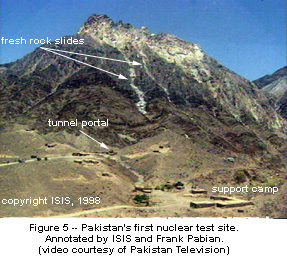
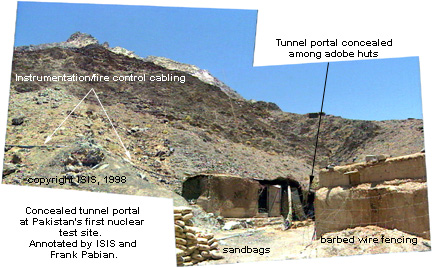


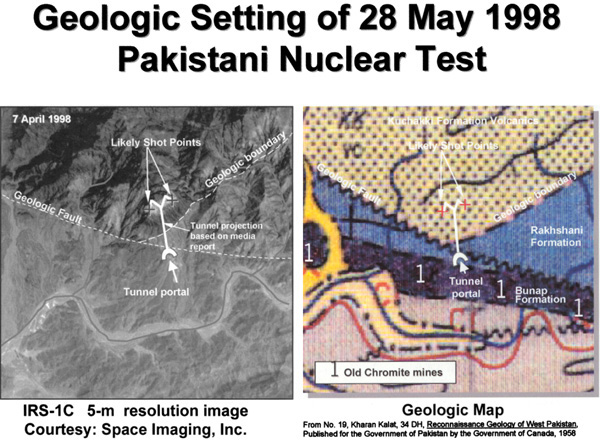
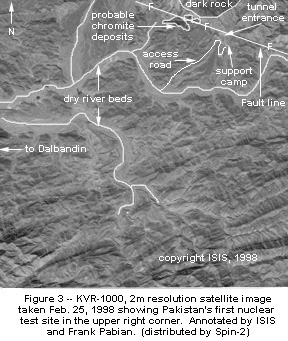
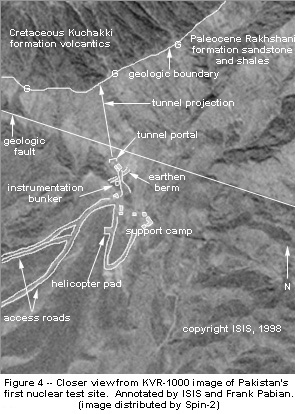
 This image has been resized. Click this bar to view the full image. The original image is sized 750x631 and weights 186KB.
This image has been resized. Click this bar to view the full image. The original image is sized 750x631 and weights 186KB.
